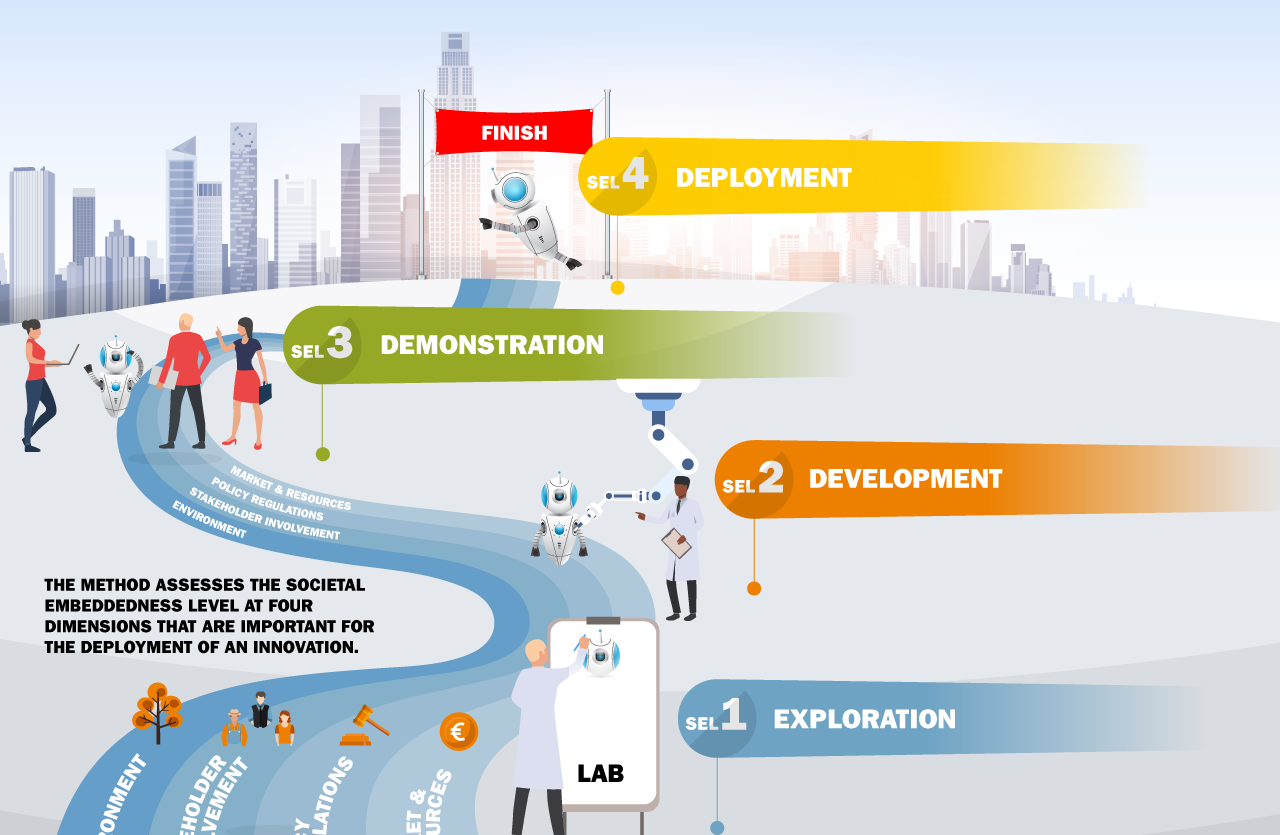
SEL method: assessing the societal ‘readiness’ of an innovation
When is an innovation ready to be launched onto the market? Developers of innovations often take too little account of societal aspects, which are crucial for a successful implementation. That is why TNO has devised SEL (Societal Embeddedness Level), a new method that goes beyond Technical Readiness Level (TRL) and assesses the level of societal embeddedness.
It is not just technical but also societal factors that determine whether an innovation is ready for implementation. Many commonly-occurring delays in implementing innovations – or abandoning them altogether – have nothing to do with technological challenges, but with societal obstacles and uncertainties that affect an innovation process. A good example is that of the coronavirus app. It will not be a success if it is not accepted by members of the public on account of privacy fears.

SEL method: assessing innovation for its societal factors
It is therefore crucial to anticipate societal effects well in advance, before launching your innovation unto market. SEL is a new method that can accelerate the successful launch of innovations by providing a clear picture of the societal – that is, non-technological – challenges that exist and of how to approach them, so that innovations can be integrated into society more effectively.
‘An interdisciplinary team is working hard on the development of SEL’
Why does the SEL method go beyond TRL?
The ‘Technical Readiness Level’ (TRL) is currently used worldwide to indicate what phase of development an innovation has reached. However, the TRL deals only with technological developments. There are some questions it does not answer. Is society ready for this? What is the legal and regulatory situation? And what about funding and the business case? ‘For some years, we had been wondering if there was a way of being able to better determine to what degree a particular technology was embedded in society’, explains Tara Geerdink of the Strategic Analysis & Policy unit. ‘We looked for a way that could help researchers and developers better understand what aspects they should consider when developing an innovation, apart from the technology process itself.’
Interdisciplinary team
After it quickly became clear that there was indeed a need for a method that showed the extent to which society is ‘ready’ for an innovation, an interdisciplinary team started developing SEL in early 2019. Geerdink: ‘We developed the methodology so it can be used for any technology, innovation, project, or system. Obviously, a key priority is that it is scientifically substantiated and its applicability is tested in practice.’
How does the SEL method work?
SEL is a continuation of the TRL methodology and offers a system that shows the degree to which an innovation is embedded in society and which challenges lie ahead. SEL looks at different societal dimensions – impact on surroundings, involvement of stakeholders, legislation and regulation, and market and financial resources. This gives the developers of innovations and researchers a good understanding of the societal preconditions they need to bear in mind as their innovations progress. They can then use this information to decide on how best to develop their strategy, in parallel with the development of the technology, for introducing the technology to society.
‘Societal aspects are also important when it comes to developing technology’
When societal embedding leaves to be desired
In short, SEL shows what societal aspects should be given extra consideration as a technology develops. Given that it’s an addition to the TRL, both instruments are directly linked: a low TRL corresponds to a low SEL, and vice versa. However, if there is a high TRL and a low SEL – that is, the technological development is well advanced, but societal embedding leaves something to be desired – then there is a societal challenge that must first be met before the technology can be launched. For example: the upscaling of solar panels on land would be technical possible (innovation has a high TRL), but because of social resistance and long lasting, unclear licensing procedures this is not (yet) realised on a big scale in The Netherlands.
Continued development
SEL is currently at the ‘work in progress’ stage. Geerdink: ‘We are still in the process of optimising the methodology. At the same time, we are testing the SEL method in a European research project involving innovative monitoring of underground CO2 storage (ACT DigiMon). In that sense, it is therefore very much a matter of continuing development and testing in practice – an iterative process.’
Get inspired
Reduce Europe’s dependence on Chinese wind power and electrolysers


Research TNO and HCSS: Europe under pressure from Chinese advance in wind and electrolysis technology


Orchestrating Innovation

Mission oriented research and innovation policy

Gridmaster cooperation energy infrastructure port of Rotterdam

